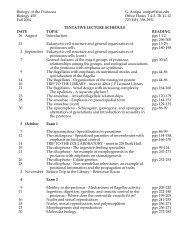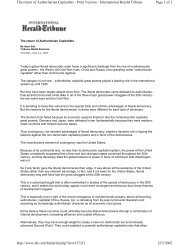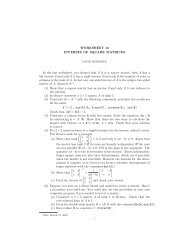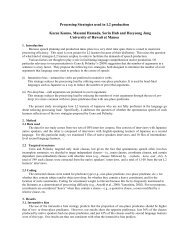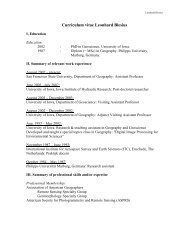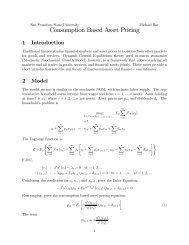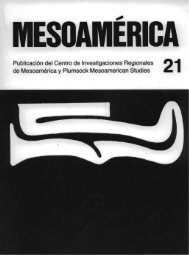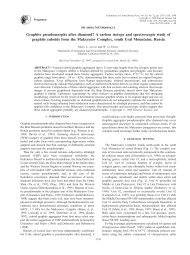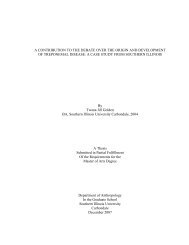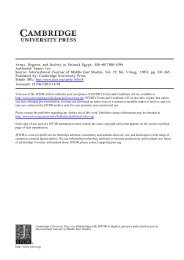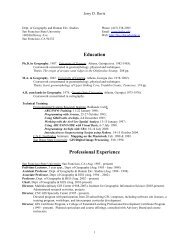Anth 760 Syllabus - Online Sfsu
Anth 760 Syllabus - Online Sfsu
Anth 760 Syllabus - Online Sfsu
You also want an ePaper? Increase the reach of your titles
YUMPU automatically turns print PDFs into web optimized ePapers that Google loves.
COURSE SYLLABUS<br />
ANTHROPOLOGY <strong>760</strong>: SEMINAR IN BIOLOGICAL ANTHROPOLOGY<br />
Semester: Fall 2013 Section: 1 (W 5:10 - 7:55, SCI 273)<br />
Instructor: Mark C. Griffin<br />
Phone: 338-7519<br />
Office Hours: MF 12:00-2:00 or by appt.<br />
Office: 395 Science<br />
E-mail: mgriffin@sfsu.edu<br />
DESCRIPTION:<br />
The purpose of this course is to give students a graduate-level understanding of the historically<br />
significant and contemporary biological anthropology primary literature. Over the course of the<br />
semester, the student will become conversant in the significance for the discipline of anthropology<br />
of the following topics: evolutionary theory, primatology, the primate fossil record, human<br />
diversity, anthropological genetics, and NAGPRA.<br />
COURSE REQUIREMENTS:<br />
(1) Each week each participant will use electronic library resources to find and read the assigned<br />
literature. A précis will be prepared for each article from the assigned reading. Each précis<br />
should begin with the citation of the reading selection (using Current <strong>Anth</strong>ropology style), be<br />
about two pages in length, and should summarize and briefly critically evaluate the reading.<br />
The précis will contribute 60% toward your final grade for the course.<br />
(a) Readings will be completed in advance of the scheduled meeting. At least a week before<br />
the scheduled meeting, the instructor will suggest some questions that could be pursued<br />
during your reading and reflection. These questions will be intended to be only suggestive,<br />
not comprehensive, or definitive.<br />
(b) The commentary portion of your précis should be a response to the issues they raise along<br />
with questions that you think should be addressed during our meetings. They should try to<br />
make connections across some or all of the week's readings. And, as the seminar unfolds<br />
week by week, it is especially productive to see what points can be made, and questions<br />
raised, that join readings and discussions one week with prior weeks' readings and<br />
discussions.<br />
(c) The précis should be completed and emailed to the instructor in a WORD document no later<br />
than 5pm Friday of the preceding week.<br />
(d) At least a day before the meeting of the seminar all of the précis will be posted on the<br />
course website as a pdf document. Students should read all of the précis before the<br />
meeting.<br />
(e) Each participant will also submit two discussion topic items each week prior to the week’s<br />
meeting time. These should be appended to the week’s précis.<br />
(2) Each week each participant will fully participate in the discussion. That is, you should come<br />
prepared with notes from the assigned articles for discussion, discussion points, and questions<br />
for further consideration. Your active participation will contribute 40% toward your final grade<br />
for the course.<br />
~ 1 ~
TEXTBOOKS:<br />
There are no texts for this class. You will be reading from the primary literature.<br />
One of the most important things that a graduate student must be proficient at is finding appropriate<br />
sources of literature and learning how to efficiently navigate the library system of your campus. To<br />
this end, you will be learning how to navigate our electronic journal resources by finding the articles<br />
for each week. In doing so, you should take note of the easiest ways to find the widest bodies of<br />
appropriate literature. You should also begin developing a list of potential journals for your thesis<br />
research.<br />
ATTENDANCE POLICY:<br />
Be here.<br />
ASSIGNMENT POLICY:<br />
Due to the nature of the assignments, they cannot be turned in late except in extremely dire<br />
circumstances and only with the prior approval of the instructor. Jammed printers, obstinate<br />
computers, incompetent computer users, recalcitrant cars, dead pets, irritating viruses, busy<br />
schedules, and general lack of prior planning are not valid excuses for late assignments.<br />
Documented catastrophic illness (bubonic plague, typhoid, malaria) or death (yours) may be<br />
considered in exceptional cases.<br />
You will be held responsible for all information presented in lectures, assigned readings, and<br />
any other media (i.e., films, video tapes, slides, etc.). The assigned readings are meant to<br />
compliment the material presented in class, not substitute for it (i.e., attend lectures if you plan<br />
to pass the course).<br />
~ 2 ~
SCHEDULE<br />
TOPIC<br />
READING<br />
Aug 28 The Discipline of Biological <strong>Anth</strong>ropology Calcagno 2003<br />
Armelagos and Van Gerven<br />
2003<br />
Sep 4 The Evolutionary Perspective Freeman 1974<br />
Weiss et al. 2011<br />
Sep 11<br />
Taxonomies and Phylogenies – Theory and Method<br />
Applied to Fossil and Living Species<br />
Cartmill 2012<br />
Begun 2010<br />
Sep 18 Contemporary Perspectives on Natural Selection Van Blerkom 2003<br />
Duncan et al. 2005<br />
Sep 25 Primate Biology Chapman and Onderdonk<br />
1998<br />
McGraw and Daegling 2012<br />
Oct 2 Primate Behavior Strum 2012<br />
Perry 2006<br />
Oct 9<br />
Oct 16<br />
Oct 23<br />
Early Primate Fossil Record (60mya-10mya) – The<br />
Origin of Primates<br />
Early Hominid Fossil Record (10mya-2mya) – The<br />
Origins of Hominina<br />
Late Hominina Fossil Record (2mya-50kya) – The<br />
Origins of the genus Homo<br />
Sussman et al. 2013<br />
Ross 2000<br />
Richmond et al. 2001<br />
Sayers et al. 2012<br />
Proctor 2003<br />
Trinkaus 2005<br />
Oct 30 Human Diversity Templeton 1999<br />
Edwards 2003<br />
Nov 6 <strong>Anth</strong>ropological Genetics Hoeyer 2005<br />
Ehrlich and Feldman. 2003<br />
Nov 13 Molecular Perspectives in Biological <strong>Anth</strong>ropology Fu et al. 2013<br />
Kaestle and Horsburgh 2002<br />
Nov 20 Bioarchaeology Knudson and Stojanowski<br />
2008<br />
Agarwal 2012<br />
Dec 4 <strong>Anth</strong>ropology and NAGPRA Dongoske 1996<br />
Jones and Harris 1998<br />
~ 3 ~
BIBLIOGRAPHY<br />
Agarwal, Sabrina C. 2012. The past of sex, gender, and health: Bioarchaeology of the aging skeleton. American<br />
<strong>Anth</strong>ropologist 114:322-335.<br />
Armelagos, George J. and Dennis P. Van Gerven. 2003. A century of skeletal biology and paleopathology: Contrasts,<br />
contradictions, and conflicts. American <strong>Anth</strong>ropologist 105(1):53-64.<br />
Begun, David R. 2010. Miocene hominids and the origins of the African apes and humans. Annual Review of<br />
<strong>Anth</strong>ropology 39:67-84.<br />
Brace, C. Loring. 1997. The intellectual standing of Charles Darwin, and the legacy of the “Scottish Enlightenment” in<br />
biological thought. Yearbook of Physical <strong>Anth</strong>ropology 40:91-111.<br />
Calcagno, James M. 2003. Keeping biological anthropology in anthropology, and anthropology in biology. American<br />
<strong>Anth</strong>ropologist 105(1):6-15.<br />
Cann, Rebecca L. 1992. "A mitochondrial perspective on replacement or continuity in human evolution," in Continuity<br />
or Replacement: Controversies in Homo sapiens Evolution. Edited by Günter Bräuer and Fred H. Smith, pp. 65-73.<br />
Rotterdam: Balkema.<br />
Cartmill, Matt. 2012. Primate origins, human origins, and the end of higher taxa. Evolutionary <strong>Anth</strong>ropology 21:208-<br />
220.<br />
Chamberlin, A.T. and Bernard A. Wood. 1987. Early hominid phylogeny. Journal of Human Evolution 16:119-133.<br />
Chapman, Colin A. and Daphne A. Onderdonk. 1998. Forests without primates: Primate/Plant codependency American<br />
Journal of Primatology 45:127-141.<br />
Darwin, Charles, Jos D. Hooker, Charles Lyell, George Sarton, and Alfred Russel Wallace. 1930. Discovery of the<br />
theory of natural selection. Isis 14(1):133-154.<br />
Dongoske, Kurt E. 1996. The Native American Graves Protection and Repatriation Act: A new beginning, not the end,<br />
for osteological analysis – A Hopi perspective. American Indian Quarterly 20(2):287-296.<br />
Duncan, S.R., S. Scott, and C.J. Duncan. 2005. Reappraisal of the historical selective pressures for the CCR5-Δ32<br />
mutation. Journal of Medical Genetics 42:205-208.<br />
Edwards, A.W.F. 2003. Human genetic diversity: Lewontin’s fallacy. BioEssays 25(8):798-801.<br />
Ehrlich, Paul and Marcus Feldman. 2003. Genes and cultures: What creates our behavioral phenome? Current<br />
<strong>Anth</strong>ropology 44(1):87-107.<br />
Freeman, Derek. 1974. The evolutionary theories of Charles Darwin and Herbert Spencer. Current <strong>Anth</strong>ropology<br />
15(3):211-237.<br />
Fu, Qiaomei, Alissa Mittnik, Philip L.F. Johnson, Kirsten Bos, Martina Lari, et al. 2013. A revised timescale for human<br />
evolution based on ancient mitochondrial genomes. Current Biology 23:553-559.<br />
Fuentes, Agustin. 2007. “Social organization: Social systems and the complexities in understanding the evolution of<br />
primate behavior,” in Primates in Perspective. Edited by Christina J. Campbell, Agustin Fuentes, Katherine C.<br />
MacKinon, Melissa Panger, and Simon K. Bearder, pp. 609-621. New York: Oxford University Press.<br />
Gould, Stephen Jay. 1982. Darwinism and the expansion of evolutionary theory. Science 216:380-387.<br />
Gould, Stephen Jay. 1989. Through a lens, darkly: Do species change by random molecular shifts or natural selection?<br />
~ 4 ~
Natural History 98(9):16-24.<br />
Gravlee, C.C. 2009. How race becomes biology: Embodiment of social inequality. American Journal of Physical<br />
<strong>Anth</strong>ropology 139:47–57.<br />
Harrison, T. 1993. "Cladistic concepts and the species problem in hominoid evolution," in Species, Species Concepts<br />
and Primate Evolution. Edited by William H. Kimbel and L.B. Martin, pp. 345-372. New York: Plenum Press.<br />
Hoeyer, Klaus. 2005. Studying ethics as policy: The naming and framing of moral problems in genetic research.<br />
Current <strong>Anth</strong>ropology 46:S71-S90.<br />
Jones, D. Gareth and Robyn J. Harris. 1998. Archaeological human remains: Scientific, cultural, and ethical<br />
considerations. Current <strong>Anth</strong>ropology 39(2):253-264.<br />
Kaestle, Frederika A. and K. Ann Horsburgh. 2002. Ancient DNA in anthropology: Methods, applications, and ethics.<br />
Yearbook of Physical <strong>Anth</strong>ropology 45:92-130.<br />
Knudson, Kelly J. and Christopher M. Stojanowski. 2008. New directions in bioarchaeology: Recent contributions to<br />
the study of human social identities. Journal of Archaeological Research 16:397-432.<br />
Mayr, Ernst. 1984. What is Darwinism today? Proceedings of the Biennial Meeting of the Philosophy of Science<br />
Association 2:145-156.<br />
Mayr, Ernst. 1996. What is a species and what is not? Philosophy of Science 63(2):262-277.<br />
McDade, Thomas W. 2005. The ecologies of human immune function. Annual Review of <strong>Anth</strong>ropology 34:495-521.<br />
McGraw, W. Scott and David J. Daegling. 2012. Primate feeding and foraging: Integrating studies of behavior and<br />
morphology. Annual Review of <strong>Anth</strong>ropology 41:203-219.<br />
McHenry, Henry M. and Katherine Coffing. 2000. Australopithecus to Homo: Transformations in body and mind.<br />
Annual Review of <strong>Anth</strong>ropology 29:125-146.<br />
Mellars, Paul. 2005. The impossible coincidence. A single-species model for the origins of modern human behavior in<br />
Europe. Evolutionary <strong>Anth</strong>ropology 14:12-27.<br />
Miller, Ellen R., Gregg F. Gunnell, and Robert D. Martin. 2005. Deep time and the search for anthropoid origins.<br />
Yearbook of Physical <strong>Anth</strong>ropology 48:60-95.<br />
O’Rourke, Dennis H., M. Geoffrey Hayes, and Shawn W. Carlyle. 2000. Ancient DNA studies in physical<br />
anthropology. Annual Review of <strong>Anth</strong>ropology 29:217-242.<br />
Ousley, Stephen D., William T. Billeck, and R. Eric Hollinger. 2005. Federal repatriation legislation and the role of<br />
physical anthropology in repatriation. Yearbook of Physical <strong>Anth</strong>ropology 48:2-32.<br />
Perry, Susan E. 2006. What cultural primatology can tell anthropologists about the evolution of culture. Annual Review<br />
of <strong>Anth</strong>ropology 35:171-190.<br />
Plummer, Thomas. 2004. Flaked stones and old bones: Biological and cultural evolution at the dawn of technology.<br />
Yearbook of Physical <strong>Anth</strong>ropology 47:118-164.<br />
Proctor, Robert N. 2003. Three roots of human recency: Molecular anthropology, the refigured Acheulian, and the<br />
UNESCO response to Auschwitz. Current <strong>Anth</strong>ropology 44(2):213-239.<br />
Richmond, Brian G., David R. Begun, and David S. Strait. 2001. Origin of human bipedalism: The knuckle-walking<br />
hypothesis revisited. Yearbook of Physical <strong>Anth</strong>ropology 44:70-105.<br />
~ 5 ~
Rose, Jerome C., Thomas J. Green, and Victoria D. Green. 1996. NAGPRA is forever: Osteology and the repatriation of<br />
skeletons. Annual Review of <strong>Anth</strong>ropology 25:81-103.<br />
Ross, Callum. 2000. Into the light: The origin of anthropoidea. Annual Review of <strong>Anth</strong>ropology 29:147-194.<br />
Sayers, Ken, Mary Ann Raghanti, and C. Owen Lovejoy. 2012. Human evolution and the chimpanzee referential<br />
doctrine. Annual Review of <strong>Anth</strong>ropology 41:119-139.<br />
Schoenemann, P. Thomas. 2006. Evolution of the size and functional areas of the human brain. Annual Review of<br />
<strong>Anth</strong>ropology 35:379-406.<br />
Sternberg, Robert J., Elena L. Grigorenko, and Kenneth K. Kidd. 2005. Intelligence, race, and genetics. American<br />
Psychologist 60(1):46-59.<br />
Strier, Karen B. 2003. Primate behavioral ecology: From ethnography to ethology and back. American <strong>Anth</strong>ropologist<br />
105(1): 16-27.<br />
Strum, Shirley C. 2012. Darwin’s monkey: Why baboons can’t become human. Yearbook of Physical <strong>Anth</strong>ropology<br />
55:3-23.<br />
Sussman, Robert W. 1992. Primate origins and the evolution of angiosperms. American Journal of Primatology 23:209-<br />
223.<br />
Sussman, Robert W., D. Tab Rasmussen, and Peter H. Raven. 2013. Rethinking primate origins again. American<br />
Journal of Primatology 75:95-106.<br />
Templeton, Alan R. 1999. Human races: A genetic and evolutionary perspective. American <strong>Anth</strong>ropologist 100(3):632-<br />
650.<br />
Templeton, Alan R. 2005. Haplotype trees and modern human origins. Yearbook of Physical <strong>Anth</strong>ropology 48:33-59.<br />
Trinkaus, Erik. 2005. Early modern humans. Annual Review of <strong>Anth</strong>ropology 34:207-230.<br />
Van Blerkom, Linda M. 2003. Role of viruses in human evolution. Yearbook of Physical <strong>Anth</strong>ropology 46:14-46.<br />
Walker, Phillip L. 2001. A bioarchaeological perspective on the history of violence. Annual Review of <strong>Anth</strong>ropology<br />
30:573-596.<br />
Ward, Carol. 2003. The evolution of human origins. American <strong>Anth</strong>ropologist 105(1):77-88.<br />
Weiss, Kenneth M., Anne V. Buchanan, and Brian W. Lambert. 2011. The red queen and her king: Cooperation at all<br />
levels of life. Yearbook of Physical <strong>Anth</strong>ropology 54:3-18.<br />
Wood, James W., George R. Milner, Henry C. Harpending, and Kenneth M. Weiss. 1992. The osteological paradox:<br />
Problems of inferring prehistoric health from skeletal samples. Current <strong>Anth</strong>ropology 33(4):343-370.<br />
Zilhão, João. 2006. Neandertals and moderns mixed, and it matters. Evolutionary <strong>Anth</strong>ropology 15:183-195.<br />
~ 6 ~



